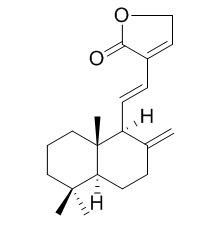Villosin
Villosin exhibits potent cytotoxic activity , it may be used as a potential lead molecule for antitumor therapeutic development. Villosin shows inhibitory effects against nitric oxide production in LPS and IFN-γ-induced RAW 264.7 murine macrophages with IC50 values of 5.99 ± 1.20 ug/ml.
Inquire / Order:
manager@chemfaces.com
Technical Inquiries:
service@chemfaces.com
Tel:
+86-27-84237783
Fax:
+86-27-84254680
Address:
1 Building, No. 83, CheCheng Rd., Wuhan Economic and Technological Development Zone, Wuhan, Hubei 430056, PRC
Providing storage is as stated on the product vial and the vial is kept tightly sealed, the product can be stored for up to
24 months(2-8C).
Wherever possible, you should prepare and use solutions on the same day. However, if you need to make up stock solutions in advance, we recommend that you store the solution as aliquots in tightly sealed vials at -20C. Generally, these will be useable for up to two weeks. Before use, and prior to opening the vial we recommend that you allow your product to equilibrate to room temperature for at least 1 hour.
Need more advice on solubility, usage and handling? Please email to: service@chemfaces.com
The packaging of the product may have turned upside down during transportation, resulting in the natural compounds adhering to the neck or cap of the vial. take the vial out of its packaging and gently shake to let the compounds fall to the bottom of the vial. for liquid products, centrifuge at 200-500 RPM to gather the liquid at the bottom of the vial. try to avoid loss or contamination during handling.
Phytomedicine.2019, 56:48-56
Food Res Int.2024, 197(Pt 1):115244.
Pharmaceutics.2023, 15(6):1771.
Metabolites.2023, 13(6):689.
Molecules.2020, 25(18),4089.
Sci Rep.2019, 9(1):18080
Korean Herb. Med. Inf.2020, 8(2):243-254.
Food Chem.2023, 404(Pt A):134517.
Phytother Res.2019, 33(3):676-689
Eur J Pharmacol.2021, 906:174220.
Related and Featured Products
Nat Prod Commun. 2014 Jul;9(7):907-10.
Abietane diterpenoids from Clerodendrum trichotomum and correction of NMR data of Villosin C and B.[Pubmed:
25230490]
METHODS AND RESULTS:
Nine abietane diterpenoids (1-9) were isolated from the stems of Clerodendrum trichotomum Thunb. and identified by spectroscopic methods. Furthermore, corrected NMR data is provided for Villosin C (1) and B (2) whose absolute configurations were elucidated from circular dichroism (CD) data. All isolates were tested for cytotoxicity against four cancer cell lines (A549, HepG-2, MCF-7 and 4T1).
CONCLUSIONS:
Compounds 1, 2, 3, 4 and 8 were found to have remarkable cytotoxic effects with IC50 values ranging from 8.79 to 35.46 microM.
Phytother Res. 2010 Jul;24(7):1009-13.
Labdane-type diterpenes from Hedychium gardnerianum with potent cytotoxicity against human small cell lung cancer cells.[Pubmed:
19960422]
METHODS AND RESULTS:
Nine abietane diterpenoids (1-9) were isolated from the stems of Clerodendrum trichotomum Thunb. and identified by spectroscopic methods. Furthermore, corrected NMR data is provided for Villosin C (1) and B (2) whose absolute configurations were elucidated from circular dichroism (CD) data. All isolates were tested for cytotoxicity against four cancer cell lines (A549, HepG-2, MCF-7 and 4T1).
CONCLUSIONS:
Compounds 1, 2, 3, 4 and 8 were found to have remarkable cytotoxic effects with IC50 values ranging from 8.79 to 35.46 microM.
Pharmacogn Rev. 2014 Jul;8(16):101-4.
Rubus fruticosus (blackberry) use as an herbal medicine.[Pubmed:
25125882]
Wild grown European blackberry Rubus fruticosus) plants are widespread in different parts of northern countries and have been extensively used in herbal medicine.
METHODS AND RESULTS:
The result show that European blackberry plants are used for herbal medicinal purpose such as antimicrobial, anticancer, antidysentery, antidiabetic, antidiarrheal, and also good antioxidant. Blackberry plant (R. fruticosus) contains tannins, gallic acid, Villosin, and iron; fruit contains vitamin C, niacin (nicotinic acid), pectin, sugars, and anthocyanins and also contains of berries albumin, citric acid, malic acid, and pectin. Some selected physicochemical characteristics such as berry weight, protein, pH, total acidity, soluble solid, reducing sugar, vitamin C, total antioxidant capacity, antimicrobial screening of fruit, leaves, root, and stem of R. fruticosus, and total anthocyanins of four preselected wild grown European blackberry (R. fruticosus) fruits are investigated. Significant differences on most of the chemical content detect among the medicinal use.
CONCLUSIONS:
The highest protein content (2%), the genotypes with the antioxidant activity of standard butylated hydroxyanisole (BHA) studies 85.07%. Different cultivars grown in same location consistently show differences in antioxidant capacity.
Nat Prod Res. 2016 Mar 11:1-6.
New Labdane diterpenes from Hedychium yunnanense with cytotoxicity and inhibitory effects on nitric oxide production.[Pubmed:
26965832 ]
METHODS AND RESULTS:
Two new labdane diterpenes, hedychenoids A (1) and B (2), were isolated from the rhizomes of Hedychium yunnanense, together with four known ones hedychenone (3), forrestin A (4), Villosin (5) and calcaratarin C (6). Their structures were determined on the basis of NMR (1D and 2D) and mass spectroscopic analysis. Compounds 2, 3 and 5 exhibited cytotoxicity against SGC-7901 with IC50 values of 14.88 ± 0.52, 7.08 ± 0.21 and 7.76 ± 0.21 μg/ml, 3 and 5 against HeLa with IC50 values of 9.76 ± 0.48 and 13.24 ± 0.63 μg/ml, respectively.
CONCLUSIONS:
Compounds 2, 5 showed inhibitory effects against nitric oxide production in LPS and IFN-γ-induced RAW 264.7 murine macrophages with IC50 values of 6.57 ± 0.88 and 5.99 ± 1.20 μg/ml, respectively.



